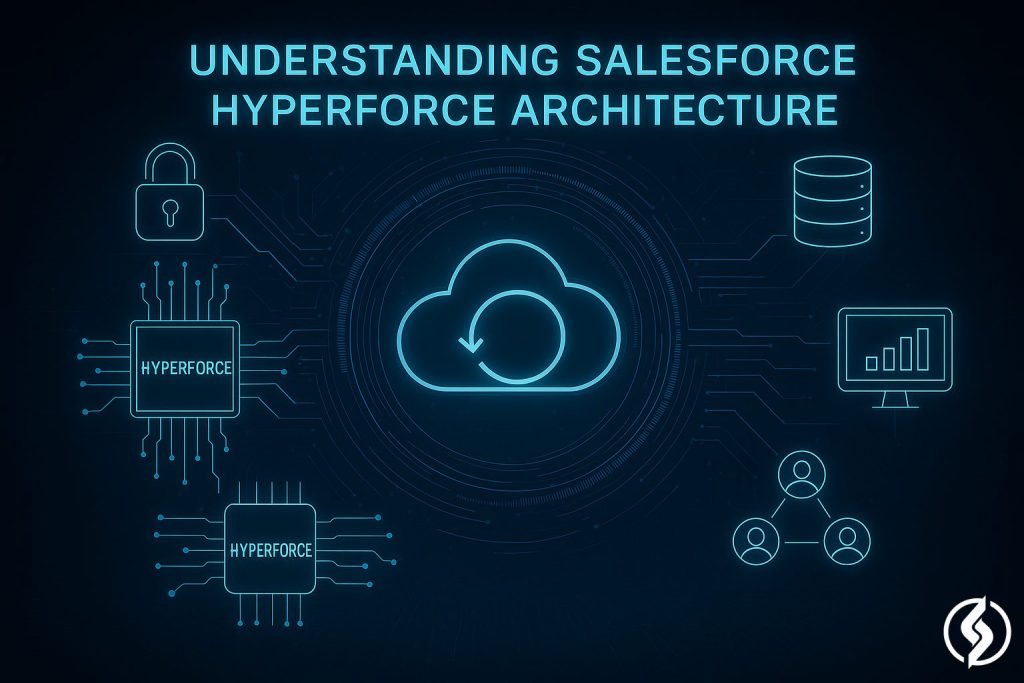Salesforce Hyperforce is the next-generation infrastructure platform that reimagines how Salesforce delivers its services to customers. Instead of relying on proprietary Salesforce data centers, Hyperforce leverages the vast global reach of public cloud providers, including AWS, Google Cloud, Azure, and Alibaba Cloud. This shift allows customers to run Salesforce applications closer to their users, with greater flexibility, speed, and regional control over their data.
Key Architectural Principles
Hyperforce is built on five core design principles that set it apart:
- Immutable Infrastructure: If there is a need for new and improved infrastructure in your company, then it will be deployed with new details. The Salesforce Architecture does not disturb the original ecosystem to create a new one. It adds to the new system and syncs it with the already established format.
- Multi-Availability-Zone Design: You can store your services and data across multiple locations within the region. It avoids the loss of data in case of a mishap and facilitates easy retrieval as well. So the next time your system falls flat, you need not worry about data loss.
- Zero Trust Security Model: Regardless of whether external or internal, the system does not trust an outside entity for fear of data loss. All access is authenticated and strictly controlled. In case you have to send the data across, it will be encrypted and securely locked to avoid any leaks.
- Infrastructure-as-Code (IaC): Every infrastructure deployment and change is managed via code and metadata in source control, allowing for standardized, automated, and auditable configuration that undergoes peer review and automated testing before rollout.
- Clean Slate Foundation: Hyperforce was built from the ground up without legacy constraints, letting Salesforce adopt modern cloud technologies and optimize for flexibility and scalability.
How Hyperforce Benefits Businesses
- Global Deployment & Scalability: Hyperforce enables businesses to quickly launch Salesforce applications in new regions without the need for physical hardware investments. This cloud-based infrastructure reduces deployment times from weeks to days and helps avoid latency, providing users with faster, more responsive experiences worldwide.
- Data Residency & Compliance: Hyperforce supports data storage within specific countries or regions, helping organizations comply with strict regulations like GDPR and HIPAA. This localized data control ensures businesses meet legal and industry standards while maintaining data privacy and security.
- Elastic Performance: Hyperforce automatically adjusts computing resources based on real-time demand. This elastic scaling ensures cost efficiency by matching capacity to usage, while consistently delivering high performance even during traffic spikes or peak usage periods.
- Accelerated Innovation: Hyperforce’s modular, cloud-native architecture is designed for continuous and rapid innovation. By abstracting infrastructure into code and containers and separating infrastructure from applications, updates to Salesforce features and services can be delivered in minor, incremental releases without any downtime. This means clients can receive the latest capabilities and performance enhancements as soon as they are available, rather than waiting for large-scale platform upgrades.
- Enhanced security and reliability: Salesforce Hyperforce boosts security and reliability by storing data across multiple cloud zones for automatic backup if one fails, using strict access controls where no one is trusted by default, and encrypting all data. Constant monitoring quickly detects problems, and every system update is applied fresh to avoid hidden risks, ensuring customer data stays safe and services remain available.
Salesforce Applications Transformed
With Hyperforce, all core Salesforce products, including Sales Cloud, Service Cloud, Marketing Cloud, and Customer 360, can now run natively on public cloud infrastructure. This empowers organizations to:
- Localize user experiences globally.
- Integrate third-party apps more easily.
- Meet local data regulations seamlessly.
- Innovate quickly with modern DevOps and IaC practices.
Why Hyperforce Is a Strategic Shift?
Hyperforce lays the groundwork for the next decade of customer innovation, making Salesforce not just cloud-based, but cloud-native at a global level. Salesforce is helping customers adapt and reduce risk at a rate never before achievable in the CRM space by switching from an outdated on-premises, hardware-centric data center model to an agile and modular public cloud infrastructure.
Salesforce is always known for top-of-the-mind recall and innovation. Hyperforce has been built along the same lines without carrying the burden of the Salesforce legacy. The infrastructure has been managed as code, organizations gain reliable deployment, built-in best security practices, and the freedom to expand anywhere their customers do.


chesterfieldph
Interesting read! The psychology of playful engagement, like with platforms such as chesterfield ph download, really impacts user experience. A safe, fun environment is key – registration seems streamlined too!
chesterfieldph
Interesting read! The psychology of playful engagement, like with platforms such as chesterfield ph download, really impacts user experience. A safe, fun environment is key – registration seems streamlined too!
bengoplus
Interesting analysis! Transparency in RTP, like with bengo plus download apk, is crucial for building trust. Seeing platforms prioritize verified RNG & localized payments (GCash etc.) is a smart move for the Philippine market!
bengoplus
Interesting analysis! Transparency in RTP, like with bengo plus download apk, is crucial for building trust. Seeing platforms prioritize verified RNG & localized payments (GCash etc.) is a smart move for the Philippine market!
jlboss
Roulette’s seemingly random nature hides fascinating probability at work! It’s cool how platforms like jiliboss are making gaming accessible – quick signup & easy funding are a big plus for enjoying those spins! Fun stuff.
jlboss
Roulette’s seemingly random nature hides fascinating probability at work! It’s cool how platforms like jiliboss are making gaming accessible – quick signup & easy funding are a big plus for enjoying those spins! Fun stuff.